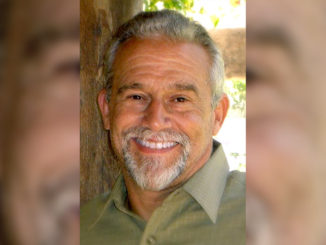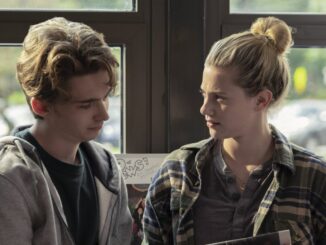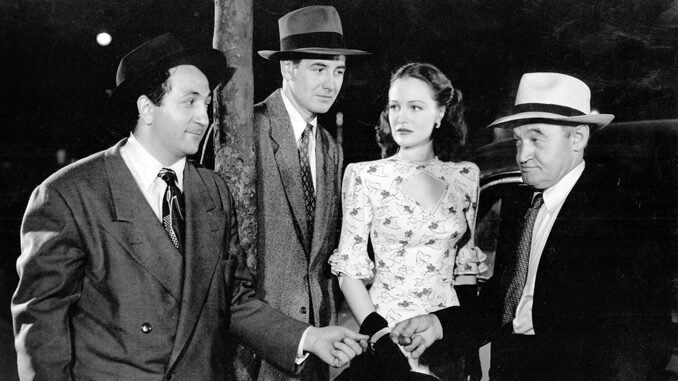
by Kevin Lewis
Sixty-five years after the semi-documentary film The Naked City (1948) premiered in March 1948, it still reveals much about New York City that has not changed. The film is the touchstone for every succeeding police procedural and forensic science crime show. The television version, called Naked City (1958-63), was also shot on the streets, and was equally honored with awards. This remains the only time both the film and television versions of a project won Academy and Emmy Awards, respectively, for picture editing and cinematography. *
The opening of the film was innovative; there were no opening credits, only a spoken narration by producer Mark Hellinger over an aerial tracking shot of Manhattan stating that this is “the story of the city and…a people without make-up.” Everything was shot on the streets of the city, and in actual buildings and apartments. The stars — Barry Fitzgerald, Don Taylor, Howard Duff and Dorothy Hart — mingled with New Yorkers playing themselves, according to Hellinger in his narration over priceless footage of 1947 New York. The lead characters themselves are not introduced with close-ups, but appear in cross-cut scenes of the city’s residents in various occupations and domestic situations: radio disc jockey, charwoman, newsroom reporter, mother and baby in a cramped bedroom, man in prison (Duff ), Lt. Dan Muldoon shaving (Fitzgerald), policeman James Halloran (Taylor) saying a morning farewell to his family, and a model being murdered in her apartment.
In reality, the many characters in the film being interviewed for the murder investigation by detectives Muldoon and Halloran were professional theatrical actors who had not appeared in films before but are recognizable to us now, such as John Randolph, Paul Ford, Arthur O’Connell and James Gregory. Yiddish actress Molly Picon has a memorable bit as a Williamsburg Bridge-area soda stand seller. Silent stars of the World War I era who hadn’t made movies in decades — Beverly Bayne and Enid Markey, the latter of whom played Jane in the original 1918 Tarzan movie — have cameos. The television series Law & Order (1987-2012) copied much from the 1948 film, including the casting of numerous accomplished New York actors in small but telling parts.
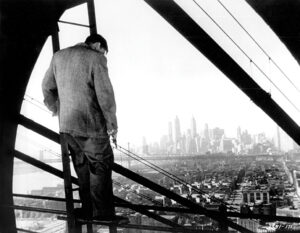
The Naked City owes its inspiration to narrator/producer Hellinger, who had died of a heart attack at 44, a few months before the film’s premiere. He was so beloved in newspaper and theatrical circles that a Broadway theatre was renamed the Mark Hellinger Theatre in 1949. Like his contemporary Damon Runyon, Hellinger was a newspaperman (New York Daily News, New York Daily Mirror) between the World Wars who created the folklore of Manhattan through his nonfiction and fictionalized accounts of theatrical and political events, as well as stories from the police blotter, in Gotham. He also wrote sketches for the Ziegfeld Follies and married one of its beauties, Gladys Glad. Warner Bros. hired him as a screenwriter of its famed film noir gangster sagas, including The Roaring Twenties (1939).
He moved to Universal after 1945 to create such noir classics starring Burt Lancaster as The Killers (1946) and Brute Force (1947). With the latter film, he found his ideal director, Jules Dassin, who came from the same neighborhood as Lancaster — East Harlem — and shared the immigrant Jewish heritage with Hellinger. Dassin was an actor in Artef, the left-wing Jewish theatre troupe, and became a director at MGM in the early 1940s.
For his final film, Hellinger took his cue from the crime and street photography of Weegee, which the photographer compiled into a book, Naked City, in 1945. With a script by Malvin Wald and Albert Maltz (using the Weegee photographs as inspiration), direction by Dassin, editing by Paul Weatherwax and cinematography by William Daniels, Hellinger brought together disparate studio talent to create The Naked City. What is remarkable about this gritty noir is that few of its cast and crew had any contact with the genre and were hardly hard-boiled characters.
Miklos Rosza, who composed the score, was known for his tension-driven soundtracks for the psychological thrillers Spellbound (1945) and A Double Life (1947), and he captured the dissonant sounds of urban society. Weatherwax, whose Oscar- winning picture editing included the intricately structured chase of the murderer through the teeming Lower East Side and across the Williamsburg Bridge, had previously edited comedies for Paramount; indeed his next Oscar, for editing Around the World in 80 Days (1956), was comedy.
Daniels, whose Academy Award-winning cinematography included both naturalistic daylight and high-contrast night shots, was known as Greta Garbo’s DP and was largely responsible for the sumptuous MGM sheen. He replicated Weegee’s unsparing candid photography for Naked City but rarely returned to this style, becoming Frank Sinatra’s frequent cinematographer in the next decade.
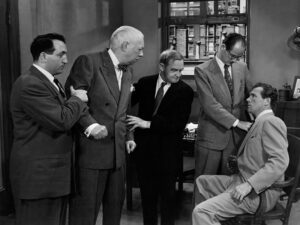
Fitzgerald was typed in brogue-laden Irish roles, such as his Oscar-winning performance as the parish priest in Going My Way (1944). Taylor played light all-American guys until he became a prominent television director a few years later. Wald, who was Oscar-nominated for his story, was a Hollywood insider as the brother of producer Jerry Wald.
Dassin became known for his film noirs and the dark side of big city life (London in Night and the City, 1950; Paris in the French Rififi, 1955), but the majority of his films were light comedies (Never on Sunday, 1960; Topkapi, 1964) or heavy- breathing melodramas (He Who Must Die, 1957; Phaedra, 1962) with his wife Melina Mercouri in Greece. His later noir, Up Tight! (1968), set in Harlem among black revolutionaries, was a misfire.
Dassin’s life would soon be changed by the Hollywood blacklist. Producer Darryl F. Zanuck tried to protect Dassin by assigning him to direct a film in London, out of reach of a HUAC (House Un-American Activities Committee) subpoena, and he produced a masterpiece, Night and the City (1950), but that was the end of his promising career in the American film industry. He refused to return to America to appear before HUAC in 1952. It took him five years of poverty as an exile in Europe before he re- established himself in France with Rififi, most famous for its half- hour burglary of a Paris jewelry store (with no sounds or dialogue on the soundtrack). Though he won the Cannes Film Festival Award for his direction of Rififi, no Hollywood industry offers resulted until the success of the Greek-made Never on Sunday, for which he received Oscar nominations for his script and direction. But he remained a European filmmaker.
The last shots of The Naked City, showing a tabloid newspaper — proclaiming “Murder Solved” over the face of the murdered model — being scooped up from the gutter by the street cleaner, tells everything about young dreams crushed by the city. The dispassionate voice of Hellinger, who everyone in the audience knew was speaking from the grave, closed the door on any O. Henry-ish or Runyonesque sentiments by delivering the now- classic line: “There are eight million stories in the naked city. This has been one of them.” It is one of the most famous final lines in moviehistory.
* The Naked City (1948)
ACADEMY AWARDS:
Best Film Editing: Paul Weatherwax.
Best Cinematography in Black-and-White: William H. Daniels. Naked City (TV series 1958-63)
EMMY AWARDS:
Best Achievement in Film Editing: Harry Coswick, Aaron Nibley, Milton Shifman (1961); Hugh Chaloupka, Aaron Nibley, Charles L. Freeman (1962).
Best Achievement in Cinematography: Jack Priestly (1962, 1963).


